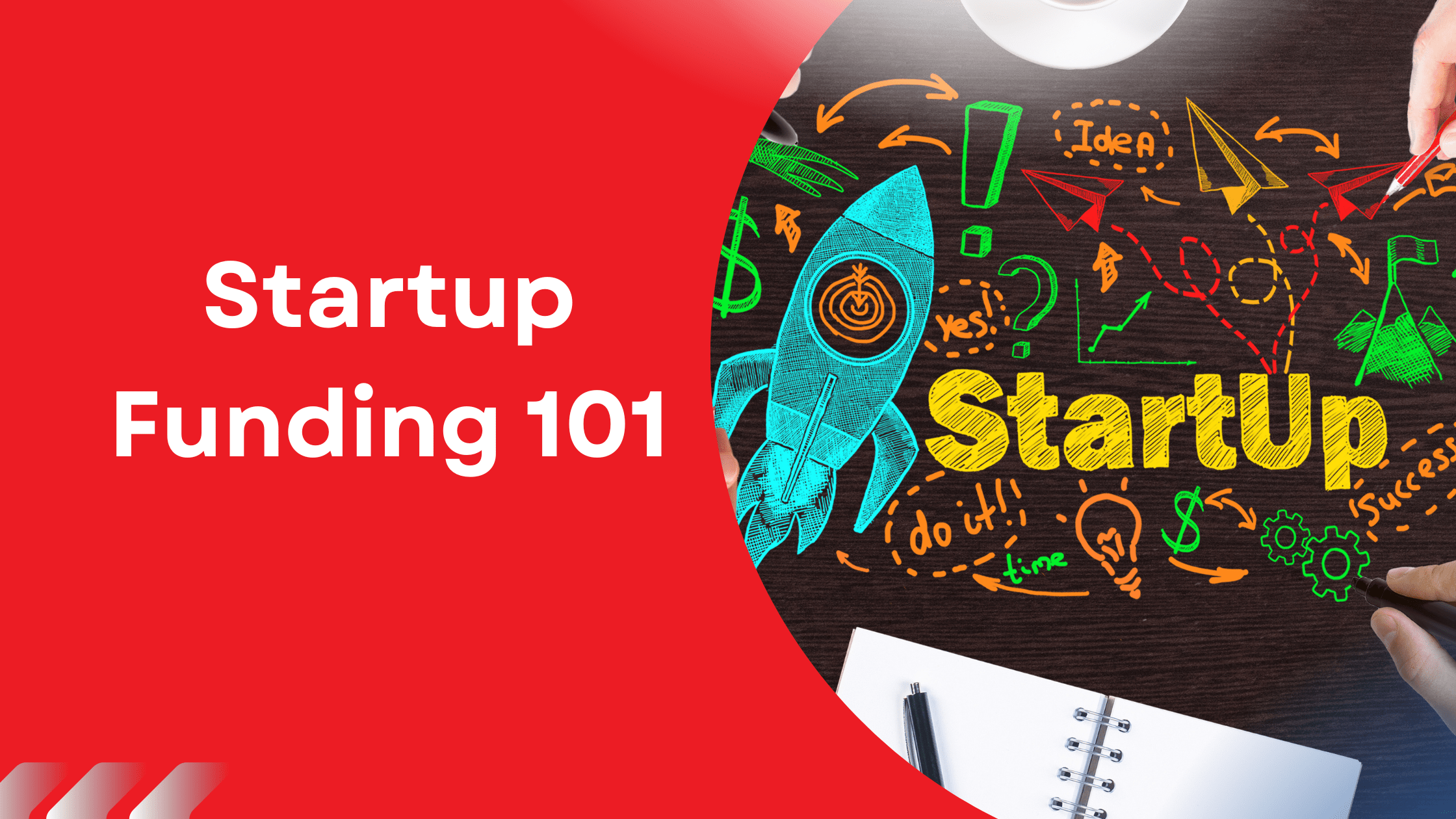One of the biggest challenges for entrepreneurs is securing funding for their startups. Without adequate funding, startups may struggle to get off the ground, scale their operations, or even fail. In this blog post, we will discuss the basics of startup funding and explore the different types of startup funding available to entrepreneurs.
Types of Startup Funding

1. Self-Funding
Self-funding or bootstrapping is a common way for entrepreneurs with early-stage startup funding to finance their startups. This involves using personal savings, credit cards, or loans to fund the business. Self-funding allows entrepreneurs to maintain control over their businesses and avoid taking on debt or giving up equity. However, it also limits the amount of capital available to the startup and may not be enough to sustain growth.
2. Angel Investors
Angel investors are wealthy individuals who invest their personal funds in startups in exchange for equity. They typically invest in the early stages of a startup and provide not only capital but also mentorship and expertise. Angel investors are often more willing to take risks than traditional investors, but they also expect a higher return on their investment.
3. Venture Capital
Venture capital firms invest in startups with high growth potential and a viable business model, pitching VC is one of the top ways in sources of startup funding. They provide large amounts of capital in exchange for equity and typically take a more hands-on approach to managing their investments. Venture capital firms often invest in startups in later stages of development and expect a high return on investment within a few years.
Pitching to Investors
When pitching to investors, it’s important to have a clear and concise business plan that outlines the company’s value proposition, market opportunity, and growth potential. Entrepreneurs should also be prepared to answer tough questions about their business and demonstrate a strong understanding of their industry and competition. It’s essential to understand the investor’s perspective and tailor the pitch accordingly. Each investor has a different investment thesis and investment criteria, and entrepreneurs should research and identify the most relevant investors for their startup.
Crowdfunding
Crowdfunding is an increasingly popular way for startups to raise funds from a large number of individuals, typically through online platforms. Crowdfunding can take different forms, such as rewards-based crowdfunding, where backers receive a product or service in exchange for their support, or equity-based crowdfunding, where backers invest in the company in exchange for equity. Crowdfunding can be a great way to validate the market demand for a product or service and build a community of supporters. However, it requires a compelling story, a clear value proposition, and a strong marketing campaign to be successful.
Grants and Accelerators
Grants and accelerators are other sources of funding for startups. Grants are non-repayable funds provided by governments, foundations, or other organizations to support specific projects or initiatives. Accelerators are programs that provide startup funding, mentorship, and resources to startups in exchange for equity. Accelerators can help startups accelerate their growth and gain access to networks and resources that can help them succeed. However, they are highly competitive, and startups need to meet specific criteria to be accepted.
Other Startup Funding Options
Other funding options for startups include debt financing, such as bank or Bitcoin loans, and strategic partnerships, where a larger company provides funding in exchange for a strategic partnership, where a larger company provides funding in exchange for a strategic partnership. Each funding option has its own advantages and disadvantages, and entrepreneurs should carefully consider which option is the best fit for their startup.
Startup Funding Rounds – How Startup Funding Works

Seed Round
A seed round is often the first round of funding that a startup receives. It typically involves raising a smaller amount of capital from angel investors or venture capital firms to fund initial product development, market research, and team building. Seed rounds usually result in the startup giving up a small amount of equity in exchange for funding.
Series A Round
A series A round is the first significant round of funding for a startup, usually occurring after the seed round. It involves raising a larger amount of capital from venture capital firms to fund further product development, marketing, and team building. Series A rounds usually result in the startup giving up a larger amount of equity in exchange for funding.
Series B Round
A series B round is a later-stage round of funding, usually occurring after the startup has achieved some level of traction and growth. It involves raising a larger amount of capital from venture capital firms to fund further expansion, product development, and team building. Series B rounds usually result in the startup giving up a significant amount of equity in exchange for funding.
Series C Round
A series C round is a later-stage round of funding, usually occurring after the startup has achieved significant growth and market share. It involves raising a large amount of capital from venture capital firms to fund further expansion, product development, and team building. Series C rounds usually result in the startup giving up a substantial amount of equity in exchange for funding.
Mezzanine Round
A mezzanine round is a later stage round of funding that is typically used to prepare a startup for an initial public offering (IPO) or acquisition. It involves raising a large amount of capital from investors, often including private equity firms, to fund further expansion and growth. Mezzanine rounds usually result in the startup giving up a significant amount of equity in exchange for funding.
- Types of Startup Funding
- Pitching to Investors
- Crowdfunding
- Grants and Accelerators
- Other Startup Funding Options
- Startup Funding Rounds – How Startup Funding Works
- Myths of Startup Funding
- Startup Funding Databases
- Templates for Email Outreach to Pitch an Investor or VC for Funding
- Top 5 VC and Investors in USA
- Top 5 VC and Investors in Germany
- Top 5 VC and Investors in United Kingdom
- Top 5 VC and Investors in South Korea
- Top 5 VC and Investors in Canada
- Top 5 VC and Investors in Switzerland
- Top 5 VC and Investors in Singapore
- Top 5 VC and Investors in Japan
- Top 5 VC and Investors in China
- Top 5 VC and Investors in Sweden
- Conclusion
- Information Sources
Myths of Startup Funding
There are several myths surrounding startup funding that can mislead entrepreneurs and prevent them from raising the capital they need to grow their businesses. Here are some common myths and misconceptions:
Myth #1: You Need a Perfect Idea
Many entrepreneurs believe that they need a perfect idea to attract investors. However, this is not necessarily true. Investors are more interested in the team behind the idea and their ability to execute on the idea than the idea itself. A good team with a mediocre idea is often more attractive to investors than a mediocre team with a great idea.
Myth #2: You Need a Large Network
Another common myth is that you need a large network to secure funding. While having a network can be helpful, it’s not a requirement. Investors are more interested in the quality of the team and the potential of the idea than the size of the entrepreneur’s network. In fact, many successful startups have been founded by entrepreneurs with small networks.
Myth #3: You Need to Be in Silicon Valley
Many entrepreneurs believe that they need to be in Silicon Valley to raise funding. While Silicon Valley is the center of the tech industry, there are many other regions and cities with vibrant startup ecosystems. Investors are interested in great ideas and talented teams, regardless of their location.
Myth #4: You Need to Raise as Much Money as Possible
Some entrepreneurs believe that they need to raise as much money as possible to be successful. However, this is not always the case. Raising too much money too early can lead to a lack of discipline and focus, and can also dilute the ownership stake of the founders. It’s important to raise the right amount of money at the right time to achieve the desired milestones and grow the business.
Myth #5: Investors Will Take Care of Everything
Another common myth is that once you secure funding, investors will take care of everything. However, this is far from the truth. While investors can provide valuable advice and connections, it’s ultimately up to the entrepreneurs to execute on the business plan and achieve the desired results. Investors expect entrepreneurs to be proactive and take responsibility for the success of the business.
By understanding these myths and misconceptions, entrepreneurs can avoid common pitfalls and increase their chances of raising the funding they need to succeed. It’s important to do your research, develop a solid business plan, and pitch to the right investors to achieve your goals.
Startup Funding Databases
There are several online databases that entrepreneurs can use to search for startup funding, including:
- Crunchbase: A comprehensive database of startups, investors, and funding rounds.
- AngelList: A platform for startups to connect with investors and raise funding.
- PitchBook: A database of private equity and venture capital firms, as well as their investments and portfolio companies.
- Gust: A platform for startups to connect with investors and manage their fundraising process.
- CB Insights: A database of startups, investors, and trends in the tech industry.
- ContactOut: A tool for finding email addresses and phone numbers of potential investors and other contacts.
These databases can be a valuable resource for entrepreneurs to research potential investors, learn about their investment criteria, and track funding trends in their industry. However, entrepreneurs should also be aware of the limitations of these databases and supplement their research with other sources of information.
Templates for Email Outreach to Pitch an Investor or VC for Funding

Here are ten templates for email outreach to pitch an investor or VC for funding:
- The Personal Connection: Start by mentioning how you found the investor or VC and why you think they would be a good fit for your startup. Make a personal connection and share your passion for your business.
- The Problem-Solution: Start by identifying a problem in the market and how your startup is solving it. Share some key metrics and explain why your business is unique.
- The Social Proof: Start by mentioning any notable investors or advisors already involved in your startup. Share some traction or customer testimonials to demonstrate your potential.
- The Milestone Update: Start by sharing an exciting milestone your startup has achieved, such as a new product launch or a major partnership. Explain how this milestone positions your startup for success.
- The Thought Leader: Start by sharing your expertise in your industry and how your startup is positioned to revolutionize it. Share some key insights and explain why your startup is the best choice for investment.
- The Industry Trend: Start by sharing some key trends in your industry and how your startup is uniquely positioned to capitalize on them. Explain why your startup is the best investment opportunity in this space.
- The Visionary: Start by sharing your long-term vision for your startup and how it will change the world. Share some key metrics and explain why your business is poised for success.
- The Partnership Pitch: Start by sharing how your startup can benefit the investor or VC’s portfolio. Explain how your business complements their existing investments and why it would be a win-win partnership.
- The Invitation: Start by inviting the investor or VC to a meeting or event to learn more about your startup. Share some key metrics and explain why your business is worth their time and attention.
- The Follow-up: Start by thanking the investor or VC for their time and attention. Share any updates or progress your startup has made since your initial outreach and ask for feedback.
Remember to personalize your pitch and tailor it to each investor or VC. Do your research and understand their investment thesis and criteria. Keep your pitch concise and compelling, and remember to follow up and maintain the relationship. Good luck!
Top 5 VC and Investors in USA
Here are the top 5 VC and investors in the USA, based on their total assets under management (AUM):
- Sequoia Capital – AUM of $50 billion
- Accel – AUM of $12 billion
- Andreessen Horowitz – AUM of $12 billion
- Founders Fund – AUM of $6 billion
- Greylock Partners – AUM of $4 billion
Top 5 VC and Investors in Germany
Here are the top 5 VC and investors in Germany, based on their total assets under management (AUM):
- Rocket Internet – AUM of $3.4 billion
- Earlybird Venture Capital – AUM of $1 billion
- Holtzbrinck Ventures – AUM of $1 billion
- Target Global – AUM of $700 million
- e.ventures – AUM of $1.4 billion
Top 5 VC and Investors in United Kingdom
Here are the top 5 VC and investors in the United Kingdom, based on their total assets under management (AUM):
- Atomico – AUM of $2.7 billion
- Balderton Capital – AUM of $2.6 billion
- Index Ventures – AUM of $2 billion
- Accel – AUM of $1.5 billion
- Northzone – AUM of $1.4 billion
Top 5 VC and Investors in South Korea
Here are the top 5 VC and investors in South Korea, based on their total assets under management (AUM):
- Korea Investment Partners – AUM of $1.8 billion
- SoftBank Ventures Asia – AUM of $1.4 billion
- STIC Investments – AUM of $1.2 billion
- IMM Investment – AUM of $1 billion
- Smilegate Investment – AUM of $860 million
Top 5 VC and Investors in Canada
Here are the top 5 VC and investors in Canada, based on their total assets under management (AUM):
- Real Ventures – AUM of $330 million
- BDC Venture Capital – AUM of $300 million
- iNovia Capital – AUM of $1.5 billion
- OMERS Ventures – AUM of $800 million
- Georgian Partners – AUM of $1.4 billion
Top 5 VC and Investors in Switzerland
Here are the top 5 VC and investors in Switzerland, based on their total assets under management (AUM):
- Creathor Venture – AUM of $520 million
- VI Partners – AUM of $250 million
- Swisscom Ventures – AUM of $200 million
- Redalpine Venture Partners – AUM of $720 million
- btov Partners – AUM of $500 million
Top 5 VC and Investors in Singapore
Here are the top 5 VC and investors in Singapore, based on their total assets under management (AUM):
- Temasek Holdings – AUM of $306 billion
- GIC Private Limited – AUM of $453 billion
- Golden Gate Ventures – AUM of $100 million
- Jungle Ventures – AUM of $350 million
- Wavemaker Partners – AUM of $400 million
Top 5 VC and Investors in Japan
Here are the top 5 VC and investors in Japan, based on their total assets under management (AUM):
- SoftBank Group – AUM of $100 billion
- Global Brain – AUM of $1.3 billion
- SBI Investment – AUM of $1.2 billion
- JAFCO – AUM of $1.1 billion
- CyberAgent Ventures – AUM of $620 million
Top 5 VC and Investors in China
Here are the top 5 VC and investors in China, based on their total assets under management (AUM):
- Qiming Venture Partners – AUM of $5 billion
- Sequoia Capital China – AUM of $4 billion
- IDG Capital – AUM of $20 billion
- Hillhouse Capital Group – AUM of $35 billion
- GGV Capital – AUM of $6.2 billion
Top 5 VC and Investors in Sweden
Here are the top 5 VC and investors in Sweden, based on their total assets under management (AUM):
- Industrifonden – AUM of $1.5 billion
- EQT Ventures – AUM of $1.2 billion
- Creandum – AUM of $600 million
- Northzone – AUM of $1.4 billion
- Almi Invest – AUM of $550 million
Conclusion
To sum up, entrepreneurs should be aware of the various funding options available to them, as startup funding is a complex and ever-changing landscape. To increase their chances of securing the funding they need, entrepreneurs should develop a solid business plan, pitch to investors, and explore all available funding options. However, funding is just one piece of the puzzle. Entrepreneurs should also focus on building a strong team, developing a great product, and executing a sound business strategy. With hard work, perseverance, and a bit of luck, entrepreneurs can turn their ideas into successful and impactful startups.
Startup funding rounds are an important part of the startup fundraising process. Each round serves a different purpose and involves raising different amounts of capital from different sources. By understanding the different types of funding rounds and their requirements, entrepreneurs can better prepare themselves for the fundraising process and increase their chances of securing the funding they need to grow and succeed.
Information Sources
Some of the sources used in this article include Crunchbase, AngelList, PitchBook, Gust, CB Insights, and various reports and publications through online databases like JSTOR, EBSCO, or ProQuest.. These sources were used to research funding trends, investor criteria, and best practices for startup fundraising.

